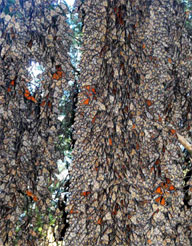We are so happy to hear that after a year’s-worth of intense effort (and mild weather), monarch butterflies are rebounding, giving us hope for the future of these gorgeous pollinators.
This winter, hibernating monarchs covered almost 10 acres in Mexico, more than tripling from 2014, when they declined to their lowest levels ever at 1.65 acres. There are about 140 million monarchs, up from 35 million, says World Wildlife Fund.
Environmental groups are cautiously saying the population is "recovering", but these numbers are still among the lowest compared to 20 years ago, when a billion monarchs covered 45 acres of Mexican forest.
It may look like bark, but it is monarchs completely covering the trees:

"We are seeing the beginning of success. Our task now is to continue building on that," Daniel Ashe, director of the US Fish and Wildlife Service (FWS), told the NY Times.
As with most wildlife losses, monarchs face multiple threats during their 2800-mile migration from Canada to Mexico and back. You probably know the greatest threat is the loss of milkweed – the sole plant they lay their eggs on and on which their larvae feed during summer. The loss of milkweed is a direct result of increased use of herbicides for GMO agriculture.
The vast increase of GMO crops across the US midwest has virtually wiped out milkweed plants, depriving monarchs of a third of their breeding ground – over 165 million acres of habitat. New research shows mature monarchs (and bees) die if they take nectar from GMO crops, in addition to being killed by spraying.
Erratic weather patterns from climate change and illegal logging in Mexico’s "monarch forest" also contribute to their demise.

Now, there’s a huge effort to plant milkweed and apparently, efforts to halt illegal logging are being successful.
Last year, milkweed grew on 250,000 more acres, either through new plantings or by stopping the use of pesticides.
FWS established the Monarch Conservation Fund – the first dedicated fund for the iconic butterflies – showing what a measly $2 million can do. Grants are given to community groups, businesses and local governments to create "monarch oases across the country." From California to the Corn Belt, and from Texas to Minnesota, habitats are being restored along the Monarch’s migration route.
You can buy seeds or plants – which must be native to your area – through Xerces Society and Monarch Watch.
A 2014 executive order from President Obama directs federal agencies to "reverse pollinator losses and help restore populations to healthy levels" of bees, birds, bats, and butterflies – as "critical contributors to our nation’s economy, food system, and environmental health." Last year, the government released a strategy to restore 7 million acres of land for pollinator habitat over the next 5 years.
And thanks to lawsuits by environmental groups, EPA is taking two of the worst herbicides off the market.
Read our article, Spring is Here: Bees & Birds Get Help From Farmers.
